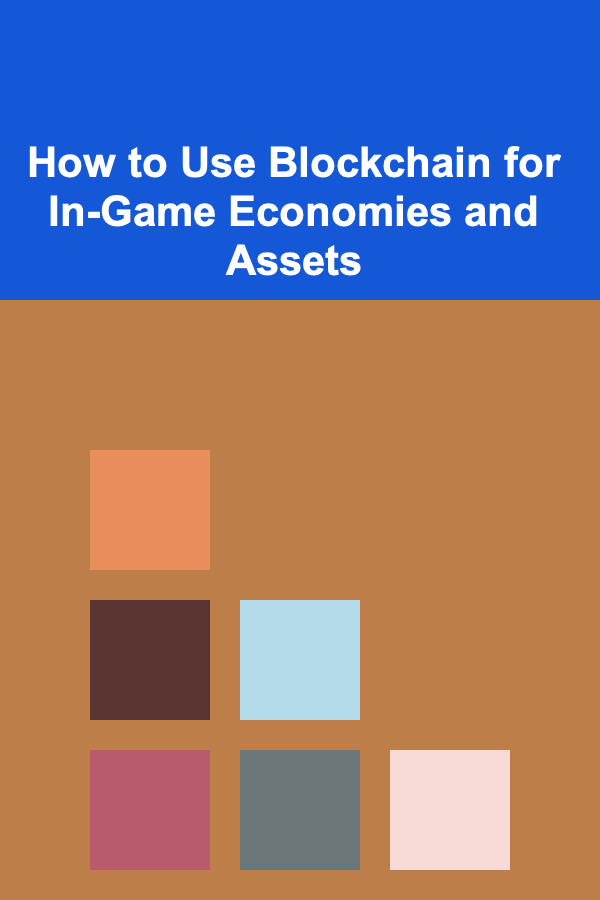
How to Use Blockchain for In-Game Economies and Assets
ebook include PDF & Audio bundle (Micro Guide)
$12.99$5.99
Limited Time Offer! Order within the next:

Blockchain technology, widely known for its association with cryptocurrencies such as Bitcoin and Ethereum, is gradually making its mark in several industries. One of the most fascinating applications of blockchain is its potential to revolutionize in-game economies and digital assets. Traditionally, in-game economies have been closed systems where players could earn, buy, and trade virtual items, but these economies were often isolated from the broader digital economy. Blockchain promises to bridge that gap, allowing for true ownership, transparency, and seamless integration with external markets.
In this article, we will explore how blockchain can be used to create more robust, transparent, and player-centric in-game economies. We will cover various concepts such as Non-Fungible Tokens (NFTs), smart contracts, and decentralized finance (DeFi) in the context of gaming. Moreover, we will examine the benefits, challenges, and future possibilities of integrating blockchain into game development and its impact on players, developers, and the gaming industry as a whole.
Understanding Blockchain Technology in Gaming
Before delving into its use in in-game economies, it's crucial to understand the core principles of blockchain technology. Blockchain is a decentralized ledger that records transactions across multiple computers. This decentralization ensures that no single entity has control over the data, making the system more secure and transparent. In the context of gaming, blockchain can be used to record in-game transactions, ownership of digital assets, and interactions between players, all in a tamper-proof way.
Key Blockchain Concepts Relevant to Gaming:
- Decentralization: A blockchain is not governed by a central authority, such as a company or government. This decentralized nature makes it perfect for creating fairer and more open in-game economies where players truly own their assets.
- Smart Contracts: These are self-executing contracts with the terms of the agreement directly written into code. In gaming, smart contracts can automate transactions, manage in-game economies, and ensure fair play by removing intermediaries and relying on transparent rules.
- Cryptocurrencies: Many blockchain-based games use cryptocurrencies as the primary medium of exchange. These digital currencies can be used to buy in-game items, trade assets, or even earn real-world money. Cryptocurrencies, such as Ethereum, provide a global, frictionless way for players to engage in in-game economies.
- Non-Fungible Tokens (NFTs): NFTs are digital assets that represent ownership of unique items. In gaming, NFTs can be used to represent in-game assets like skins, weapons, characters, land, or even achievements. Each NFT is unique and verifiable on the blockchain, ensuring scarcity and authenticity, which is crucial in creating valuable assets for players.
Blockchain in In-Game Economies
An in-game economy refers to the system through which players earn, spend, and trade in-game resources and assets. These assets can range from virtual currency, which is often used as a medium of exchange within the game, to collectibles like skins, weapons, and other rare items. Traditionally, in-game economies were closed systems controlled by the game developers. Players could buy or earn virtual currency and spend it on in-game items, but they had no true ownership of these assets outside of the game's ecosystem.
With blockchain, however, players can have true ownership of their in-game assets, and the items they earn or purchase can be traded, sold, or transferred outside of the game's closed ecosystem. Blockchain's ability to facilitate secure, peer-to-peer transactions and maintain verifiable ownership records has immense potential for reshaping in-game economies.
1. Tokenization of In-Game Assets
One of the most straightforward applications of blockchain in gaming is the tokenization of in-game assets. By converting in-game items such as skins, weapons, and characters into digital tokens (often NFTs), players can buy, sell, and trade these items on blockchain-powered marketplaces. These tokens represent ownership, and because they are verified on the blockchain, they cannot be counterfeited or duplicated, ensuring authenticity and scarcity.
For example, a player in a game like Decentraland or Axie Infinity can purchase virtual land or in-game creatures as NFTs. These items exist as digital assets on the blockchain and can be sold to other players. The blockchain records each transaction, ensuring the asset's history and ownership are publicly visible and secure. This opens up new possibilities for player-driven economies, as assets can have real-world value, creating an incentive for players to actively engage with the game.
2. Creating Play-to-Earn (P2E) Models
Blockchain technology enables a new paradigm in gaming called play-to-earn (P2E). In traditional gaming models, players purchase games or in-game items but do not have the opportunity to earn real value. With blockchain, players can earn cryptocurrency or NFTs through gameplay, which can be sold or traded on external markets.
The concept of play-to-earn has been popularized by games like Axie Infinity, where players can earn native tokens by battling with in-game creatures (Axies). These tokens can then be traded for other cryptocurrencies or used to purchase new assets. This creates an ecosystem where players are incentivized not only by entertainment but also by the opportunity to profit from their efforts in-game.
Moreover, blockchain-based games can integrate decentralized finance (DeFi) features, such as staking and yield farming, into the gameplay. For instance, players could stake their NFTs or in-game tokens to earn additional rewards, creating new ways for gamers to generate income while playing.
3. Decentralized Marketplaces and Trading
Blockchain also facilitates the creation of decentralized marketplaces where players can trade their digital assets directly with each other. Traditionally, in-game items were traded through centralized platforms, often controlled by the game developer. These platforms charged transaction fees, and players were limited to trading within the confines of the game's ecosystem.
Blockchain-based games, on the other hand, allow for peer-to-peer trading, cutting out intermediaries. Players can list their NFTs or other digital assets on decentralized exchanges or marketplaces such as OpenSea, Rarible, or Axie Marketplace. Because these assets are backed by blockchain technology, the process is secure, transparent, and trustless.
These decentralized marketplaces also open up new revenue streams for game developers. By integrating blockchain into their games, developers can earn transaction fees on the sale of in-game assets or royalties every time an item is resold on the secondary market. This creates a continuous income stream for developers while providing players with greater freedom and control over their in-game assets.
Advantages of Blockchain in In-Game Economies
The integration of blockchain into gaming offers several benefits for both players and developers. Some of the key advantages include:
1. True Ownership of Assets
Blockchain enables players to truly own their in-game assets. Unlike traditional games, where items are stored on centralized servers and can be lost if the game shuts down or the account is banned, blockchain ensures that assets are securely stored on the decentralized ledger. This means that players have full control over their assets, even outside the game.
2. Transparency and Security
Blockchain provides transparency and security in in-game transactions. Every transaction is recorded on the blockchain, making it publicly verifiable and immutable. This reduces the risk of fraud, cheating, or manipulation in the game's economy. Players can trust that the assets they purchase, sell, or trade are authentic and that the in-game economy is fair and transparent.
3. Cross-Game Interoperability
With blockchain, it becomes possible for assets to be used across different games. For example, a rare sword or character purchased in one game could potentially be used in another game, as long as both games are compatible with the same blockchain platform. This creates new possibilities for cross-game collaboration and resource-sharing, allowing for a more interconnected gaming ecosystem.
4. Play-to-Earn Models and Economic Growth
Blockchain allows for play-to-earn models, where players can earn rewards and real-world value through their in-game activities. This incentivizes players to engage more deeply with the game and can also provide economic opportunities for people in underserved regions. As a result, blockchain-based games can stimulate the growth of new economic ecosystems that benefit players, developers, and investors.
5. Reduced Costs and Intermediaries
Blockchain eliminates the need for intermediaries, such as payment processors and centralized marketplaces, which often charge high fees for transactions. This reduces transaction costs for both players and developers. Players can also trade assets directly with each other, cutting out middlemen and ensuring that the majority of the value goes to the players themselves.
Challenges and Concerns
Despite the numerous benefits of blockchain in gaming, there are several challenges and concerns that need to be addressed:
1. Scalability Issues
One of the biggest hurdles to the widespread adoption of blockchain in gaming is scalability. Current blockchain networks, such as Ethereum, can handle only a limited number of transactions per second. This can lead to high fees and slow transaction times, which are problematic in fast-paced games with a large number of players. While layer-2 solutions and other blockchain networks are being developed to address these issues, scalability remains a concern.
2. Environmental Impact
Many blockchain networks, particularly those that use proof-of-work (PoW) consensus mechanisms, consume significant amounts of energy. The environmental impact of these networks has been a point of contention. Games that rely on blockchain for their in-game economies may be contributing to carbon emissions, which has led some players and environmentalists to question the sustainability of blockchain in gaming.
3. Market Volatility
Cryptocurrencies and NFTs are subject to market volatility, and this can have a significant impact on the in-game economy. The value of in-game assets tied to cryptocurrencies or NFTs can fluctuate rapidly, leading to uncertainty and potential financial loss for players. Game developers will need to carefully manage the economic models to ensure stability and avoid speculation-driven markets.
4. Accessibility and Adoption
Blockchain-based games may be difficult for new players to access. The process of purchasing cryptocurrency, creating a digital wallet, and interacting with decentralized applications (dApps) can be intimidating for those unfamiliar with blockchain technology. Developers will need to simplify the onboarding process to make blockchain games more accessible to a wider audience.
Conclusion
Blockchain has the potential to radically transform in-game economies and digital assets. By enabling true ownership, decentralized marketplaces, and play-to-earn models, blockchain offers players new opportunities to earn, trade, and interact with their virtual assets in meaningful ways. Developers, too, stand to benefit from the transparency, security, and innovative economic models that blockchain enables.
While challenges remain, including scalability issues, environmental concerns, and market volatility, the future of blockchain in gaming is promising. As the technology matures and more developers experiment with blockchain-based gaming models, we are likely to see a growing number of games that harness the power of blockchain to create richer, more dynamic, and more rewarding gaming experiences for players around the world.

How to Create a Checklist for Each DIY Project
Read More
How to Define Clear Testing Objectives for Your Product
Read More
How to Make the Most of Under-Stair Storage in Your Home
Read More
Oral Health Optimization: Techniques and Best Practices for Dental Hygienists
Read More
How to Develop Your Story Idea from Concept to Outline
Read More
How To Cope with Burnout and Exhaustion
Read MoreOther Products

How to Create a Checklist for Each DIY Project
Read More
How to Define Clear Testing Objectives for Your Product
Read More
How to Make the Most of Under-Stair Storage in Your Home
Read More
Oral Health Optimization: Techniques and Best Practices for Dental Hygienists
Read More
How to Develop Your Story Idea from Concept to Outline
Read More